ACURA RL KA9 1996 Service Repair Manual
Manufacturer: ACURA, Model Year: 1996, Model line: RL KA9, Model: ACURA RL KA9 1996Pages: 1954, PDF Size: 61.44 MB
Page 541 of 1954
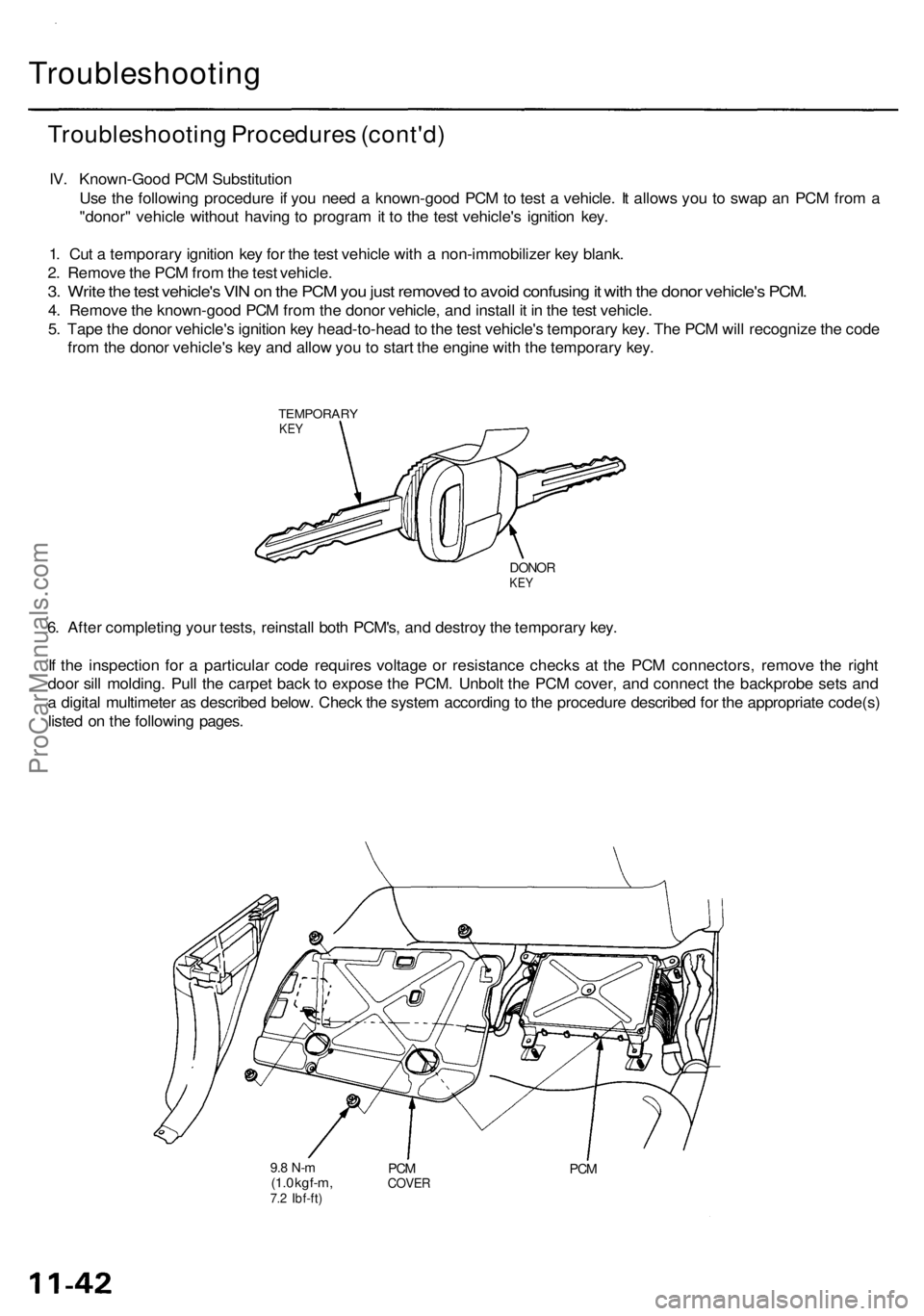
PCM
PCM
COVER
9.8 N-m
(1.0 kgf-m,
7.2 Ibf-ft)
6. After completing your tests, reinstall both PCM's, and destroy the temporary key.
If the inspection for a particular code requires voltage or resistance checks at the PCM connectors, remove the right
door sill molding. Pull the carpet back to expose the PCM. Unbolt the PCM cover, and connect the backprobe sets and
a digital multimeter as described below. Check the system according to the procedure described for the appropriate code(s)
listed on the following pages.
DONOR
KEY
TEMPORARY
KEY
Troubleshooting
Troubleshooting Procedures (cont'd)
IV. Known-Good PCM Substitution
Use the following procedure if you need a known-good PCM to test a vehicle. It allows you to swap an PCM from a
"donor" vehicle without having to program it to the test vehicle's ignition key.
1. Cut a temporary ignition key for the test vehicle with a non-immobilizer key blank.
2. Remove the PCM from the test vehicle.
3. Write the test vehicle's VIN on the PCM you just removed to avoid confusing it with the donor vehicle's PCM.
4. Remove the known-good PCM from the donor vehicle, and install it in the test vehicle.
5. Tape the donor vehicle's ignition key head-to-head to the test vehicle's temporary key. The PCM will recognize the code
from the donor vehicle's key and allow you to start the engine with the temporary key.ProCarManuals.com
Page 542 of 1954
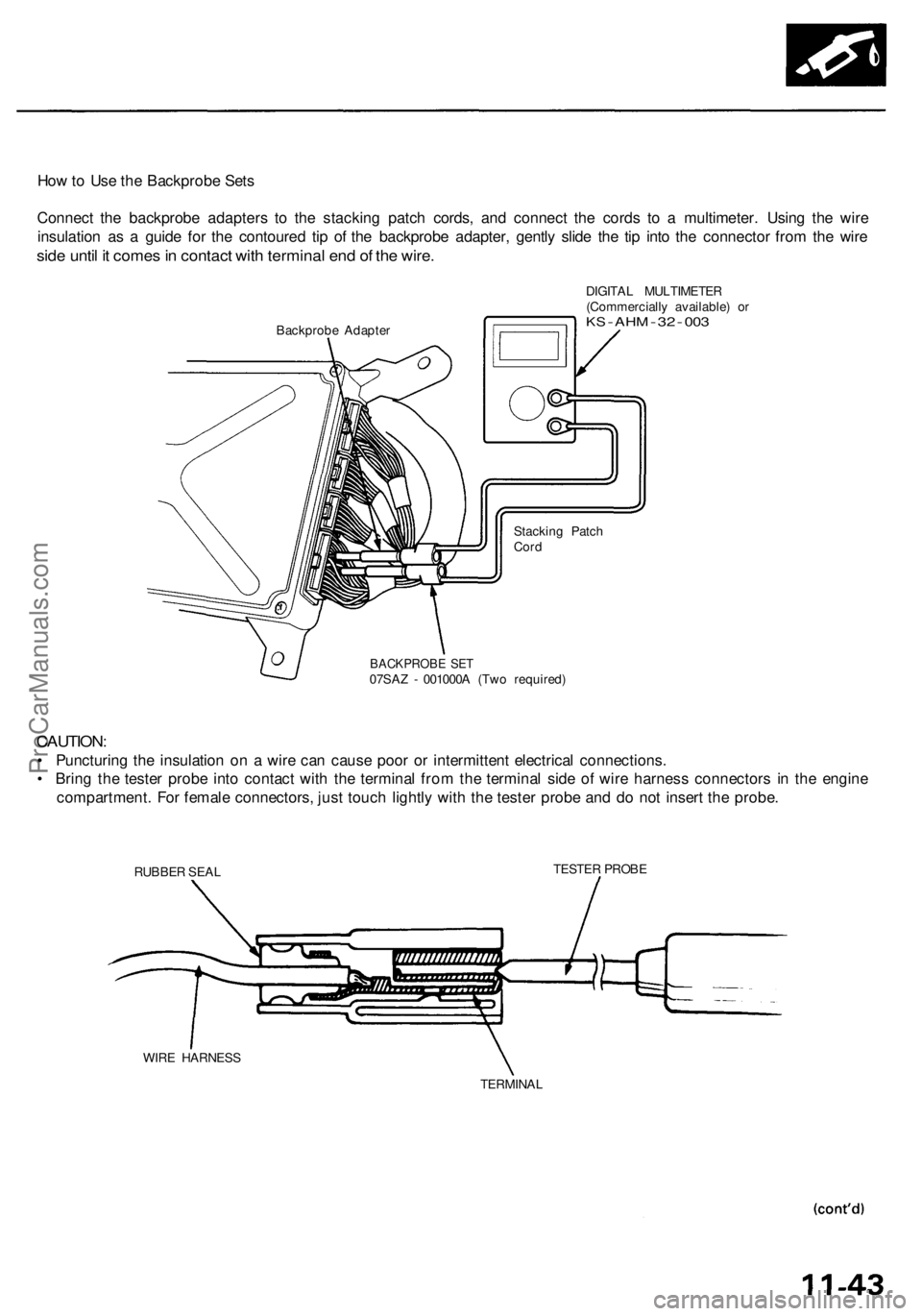
How to Use the Backprobe Sets
Connect the backprobe adapters to the stacking patch cords, and connect the cords to a multimeter. Using the wire
insulation as a guide for the contoured tip of the backprobe adapter, gently slide the tip into the connector from the wire
side until it comes in contact with terminal end of the wire.
Backprobe Adapter
DIGITAL MULTIMETER
(Commercially available) or
KS
-
AHM
-
32
-
003
Stacking Patch
Cord
BACKPROBE SET
07SAZ - 001000A (Two required)
CAUTION:
• Puncturing the insulation on a wire can cause poor or intermittent electrical connections.
• Bring the tester probe into contact with the terminal from the terminal side of wire harness connectors in the engine
compartment. For female connectors, just touch lightly with the tester probe and do not insert the probe.
TESTER PROBE
RUBBER SEAL
WIRE HARNESS
TERMINALProCarManuals.com
Page 543 of 1954
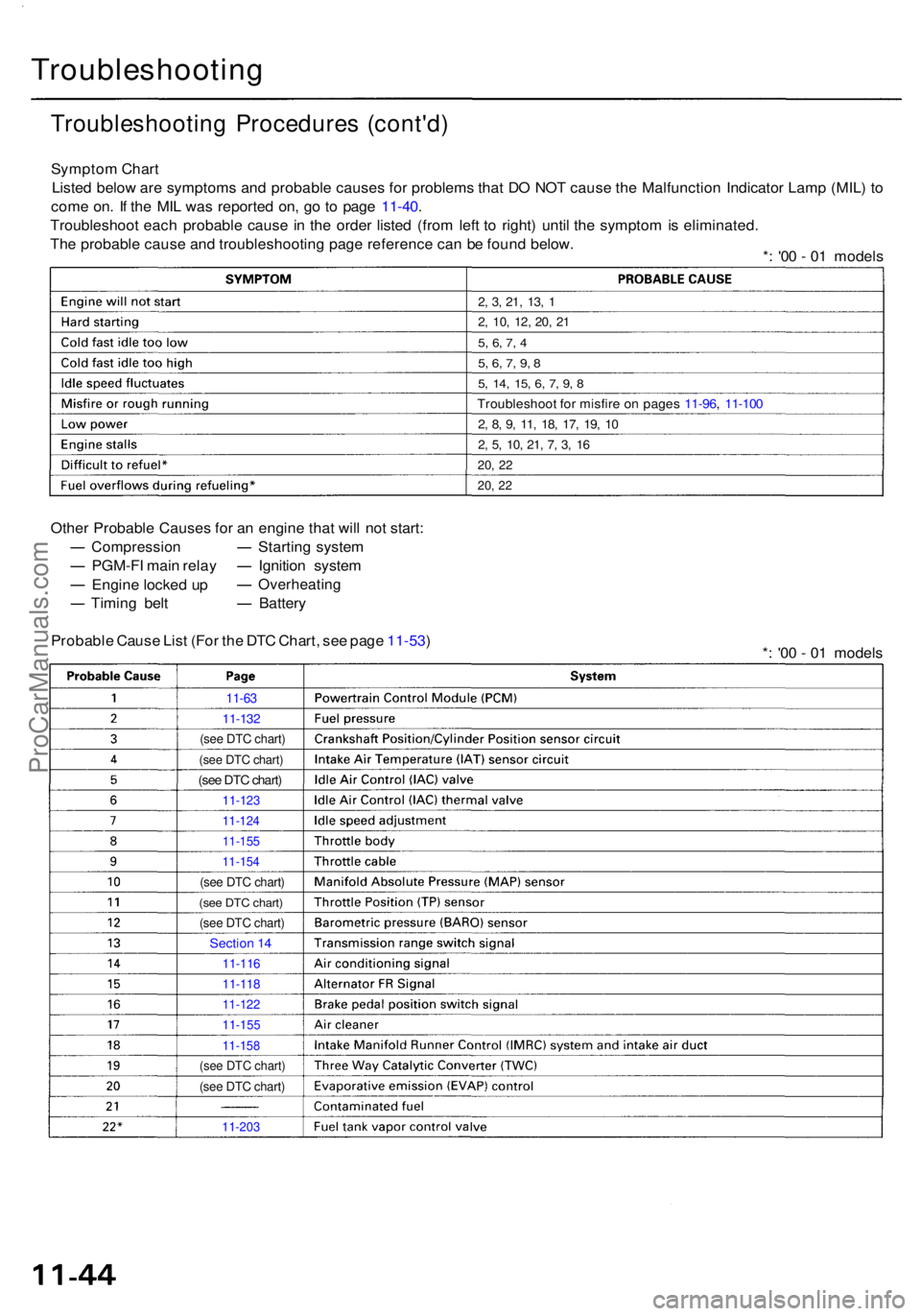
Troubleshooting
Troubleshooting Procedure s (cont'd )
Sympto m Char t
Liste d belo w ar e symptom s an d probabl e cause s fo r problem s tha t D O NO T caus e th e Malfunctio n Indicato r Lam p (MIL ) t o
com e on . I f th e MI L wa s reporte d on , g o t o pag e 11-40 .
Troubleshoo t eac h probabl e caus e i n th e orde r liste d (fro m lef t t o right ) unti l th e sympto m is eliminated .
Th e probabl e caus e an d troubleshootin g pag e referenc e ca n b e foun d below .
*: '0 0 - 0 1 model s
2, 3 , 21 , 13 , 1
2 , 10 , 12 , 20 , 2 1
5, 6 , 7 , 4
5 , 6 , 7 , 9 , 8
5 , 14 , 15 , 6 , 7 , 9 , 8
Troubleshoo t fo r misfir e o n page s 11-96 , 11-10 0
2, 8 , 9 , 11 , 18 , 17 , 19 , 1 0
2, 5 , 10 , 21 , 7 , 3 , 1 6
20 , 2 2
20 , 2 2
Othe r Probabl e Cause s fo r a n engin e tha t wil l no t start :
Compressio n
PGM-FI mai n rela y
Engin e locke d u p
Timin g bel t Startin
g syste m
Ignitio n syste m
Overheatin g
Battery
Probabl e Caus e Lis t (Fo r th e DT C Chart , se e pag e 11-53 )
*: '0 0 - 0 1 model s
11-63
11-13 2
(see DTC chart)
(see DTC chart)
(see DTC chart)
11-12 3
11-124
11-155
11-154
(see DTC chart)
(see DTC chart)
(see DTC chart)
Sectio n 1 4
11-11 6
11-118
11-122
11-15 5
11-158
(see DTC chart)
(see DTC chart)
11-20 3
ProCarManuals.com
Page 544 of 1954
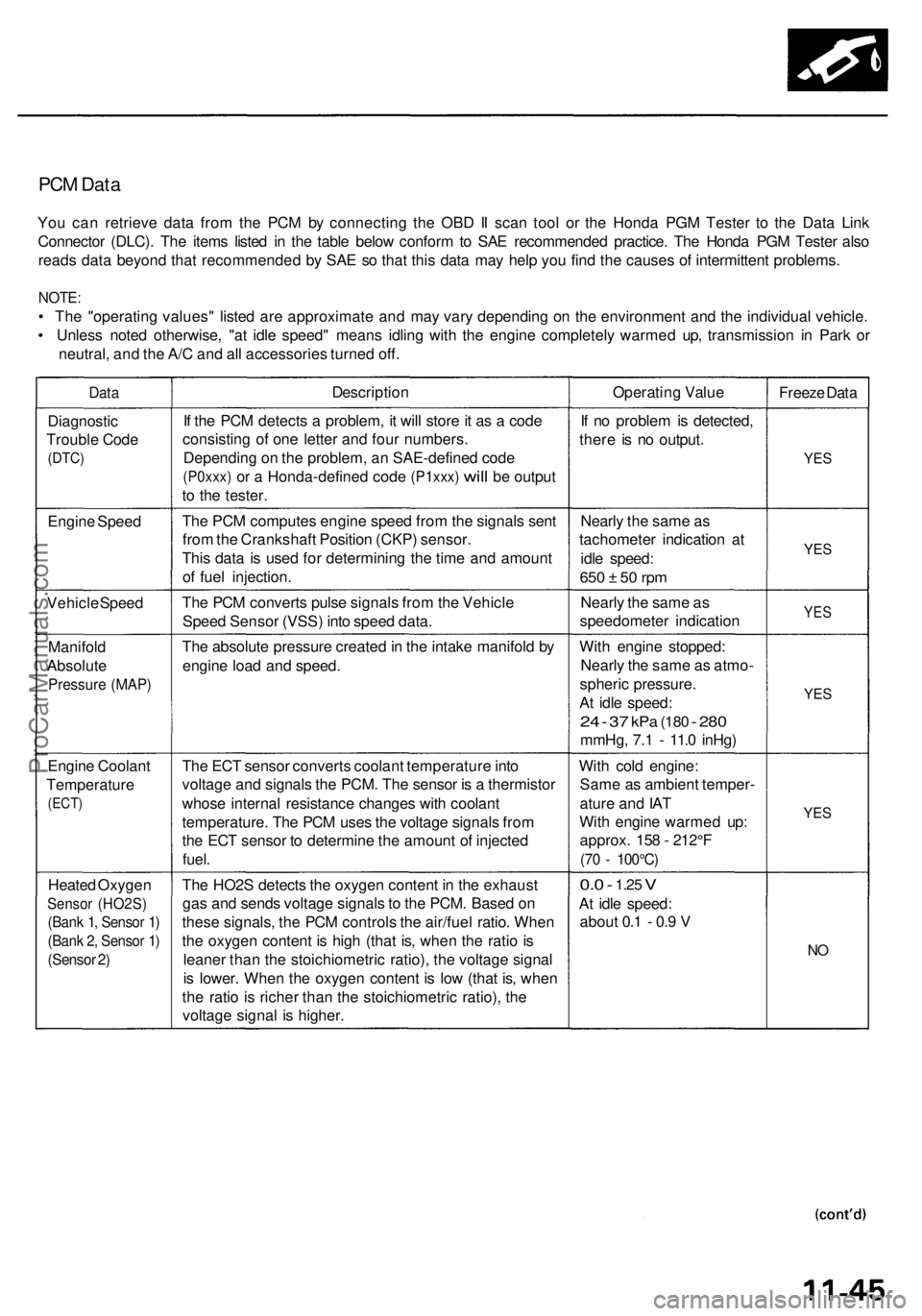
PCM Data
You can retrieve data from the PCM by connecting the OBD II scan tool or the Honda PGM Tester to the Data Link
Connector (DLC). The items listed in the table below conform to SAE recommended practice. The Honda PGM Tester also
reads data beyond that recommended by SAE so that this data may help you find the causes of intermittent problems.
NOTE:
• The "operating values" listed are approximate and may vary depending on the environment and the individual vehicle.
• Unless noted otherwise, "at idle speed" means idling with the engine completely warmed up, transmission in Park or
neutral, and the A/C and all accessories turned off.
Data
Description
Operating Value
Freeze Data
Diagnostic
Trouble Code
(DTC)
If the PCM detects a problem, it will store it as a code
consisting of one letter and four numbers.
Depending on the problem, an SAE-defined code
(P0xxx)
or a
Honda-defined code
(P1xxx)
will
be
output
to the tester.
If no problem is detected,
there is no output.
YES
Engine Speed
The PCM computes engine speed from the signals sent
from the Crankshaft Position (CKP) sensor.
This data is used for determining the time and amount
of fuel injection.
Nearly the same as
tachometer indication at
idle speed:
650 ± 50 rpm
YES
Vehicle Speed
The PCM converts pulse signals from the Vehicle
Speed Sensor (VSS) into speed data.
Nearly the same as
speedometer indication
YES
Manifold
Absolute
Pressure (MAP)
The absolute pressure created in the intake manifold by
engine load and speed.
With engine stopped:
Nearly the same as atmo-
spheric pressure.
At idle speed:
24 - 37
kPa
(180
-
280
mmHg, 7.1 - 11.0 inHg)
YES
Engine Coolant
Temperature
(ECT)
The ECT sensor converts coolant temperature into
voltage and signals the PCM. The sensor is a thermistor
whose internal resistance changes with coolant
temperature. The PCM uses the voltage signals from
the ECT sensor to determine the amount of injected
fuel.
With cold engine:
Same as ambient temper-
ature and IAT
With engine warmed up:
approx. 158 - 212°F
(70 - 100°C)
YES
Heated Oxygen
Sensor (HO2S)
(Bank 1, Sensor 1)
(Bank 2, Sensor 1)
(Sensor 2)
The HO2S detects the oxygen content in the exhaust
gas and sends voltage signals to the PCM. Based on
these signals, the PCM controls the air/fuel ratio. When
the oxygen content is high (that is, when the ratio is
leaner than the stoichiometric ratio), the voltage signal
is lower. When the oxygen content is low (that is, when
the ratio is richer than the stoichiometric ratio), the
voltage signal is higher.
0.0 -
1.25
V
At idle speed:
about 0.1 - 0.9 V
NOProCarManuals.com
Page 545 of 1954
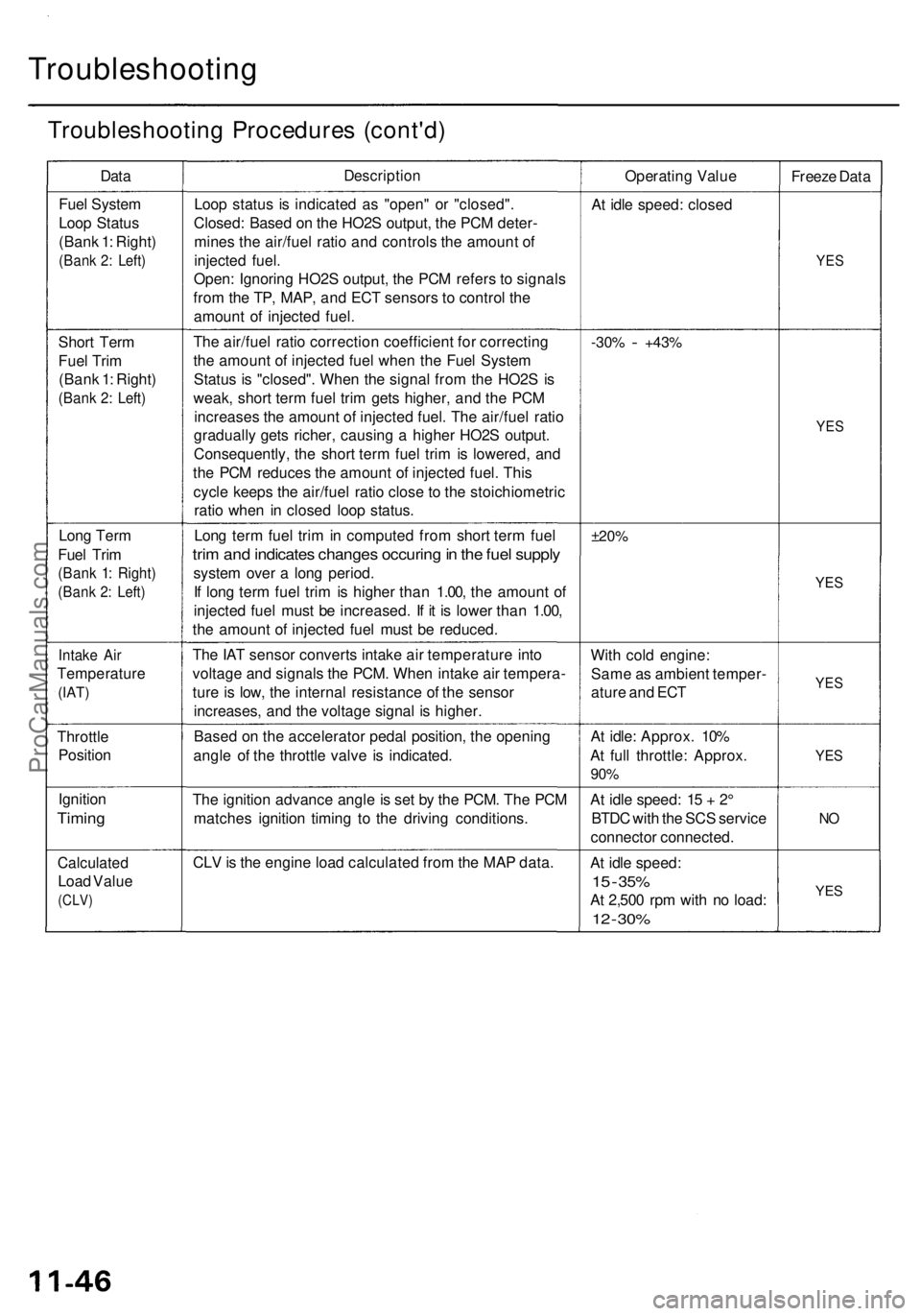
Troubleshooting
Troubleshooting Procedures (cont'd)
Data
Description
Operating Value
Freeze Data
Fuel System
Loop Status
(Bank 1: Right)
(Bank 2: Left)
Loop status is indicated as "open" or "closed".
Closed: Based on the HO2S output, the PCM deter-
mines the air/fuel ratio and controls the amount of
injected fuel.
Open: Ignoring HO2S output, the PCM refers to signals
from the TP, MAP, and ECT sensors to control the
amount of injected fuel.
At idle speed: closed
YES
Short Term
Fuel Trim
(Bank 1: Right)
(Bank 2: Left)
The air/fuel ratio correction coefficient for correcting
the amount of injected fuel when the Fuel System
Status is "closed". When the signal from the HO2S is
weak, short term fuel trim gets higher, and the PCM
increases the amount of injected fuel. The air/fuel ratio
gradually gets richer, causing a higher HO2S output.
Consequently, the short term fuel trim is lowered, and
the PCM reduces the amount of injected fuel. This
cycle keeps the air/fuel ratio close to the stoichiometric
ratio when in closed loop status.
-30%
-
+43%
YES
Long Term
Fuel Trim
(Bank 1: Right)
(Bank 2: Left)
Long term fuel trim in computed from short term fuel
trim and indicates changes occuring in the fuel supply
system over a long period.
If long term fuel trim is higher than 1.00, the amount of
injected fuel must be increased. If it is lower than 1.00,
the amount of injected fuel must be reduced.
±20%
YES
Intake Air
Temperature
(IAT)
The IAT sensor converts intake air temperature into
voltage and signals the PCM. When intake air tempera-
ture is low, the internal resistance of the sensor
increases, and the voltage signal is higher.
With cold engine:
Same as ambient temper-
ature and ECT
YES
Throttle
Position
Based on the accelerator pedal position, the opening
angle of the throttle valve is indicated.
At idle: Approx. 10%
At full throttle: Approx.
90%
YES
Ignition
Timing
The ignition advance angle is set by the PCM. The PCM
matches ignition timing to the driving conditions.
At idle speed: 15 + 2°
BTDC with the SCS service
connector connected.
NO
Calculated
Load Value
(CLV)
CLV is the engine load calculated from the MAP data.
At idle speed:
15
-
35%
At 2,500 rpm with no load:
12
-
30%
YESProCarManuals.com
Page 546 of 1954
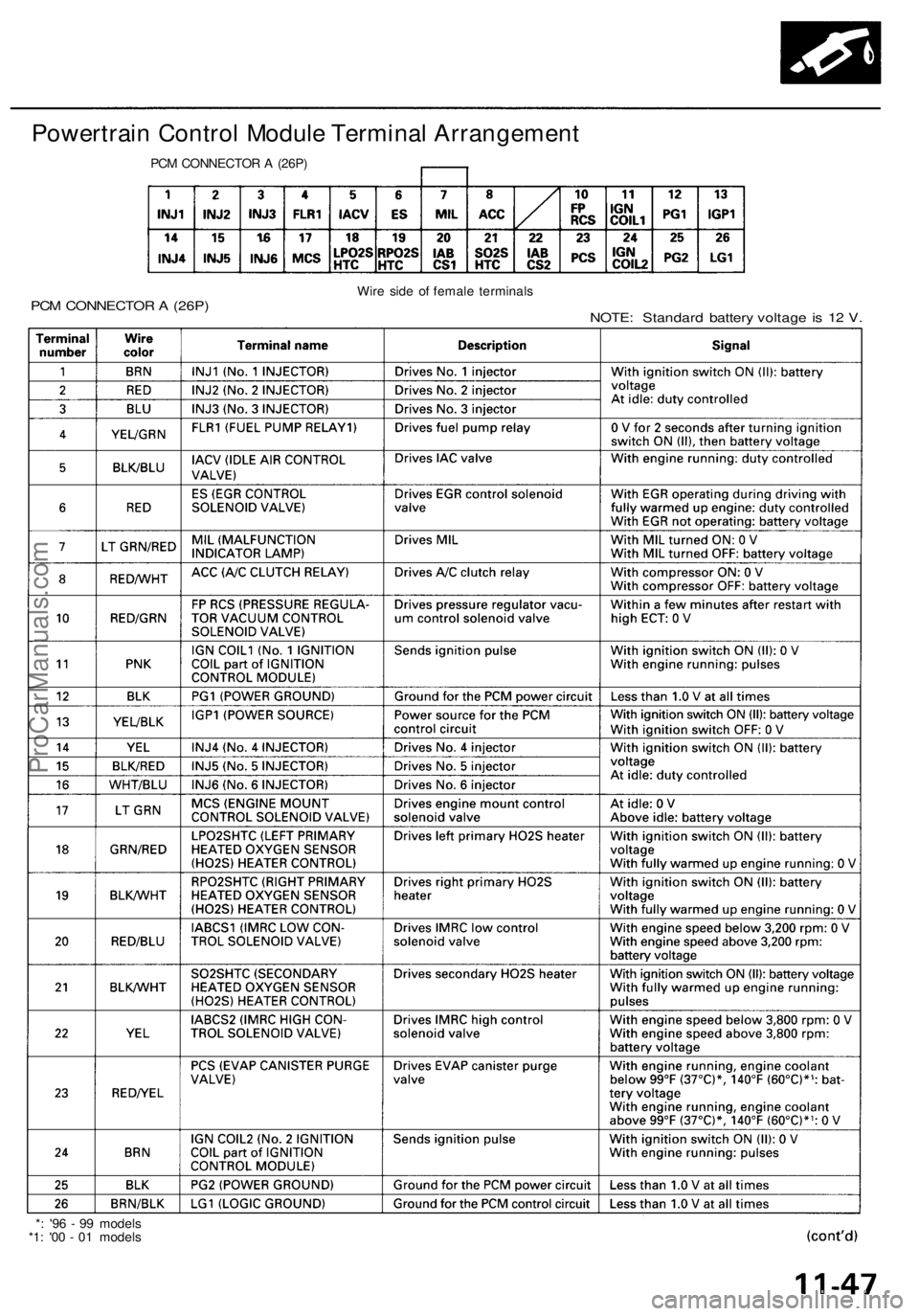
Powertrain Control Module Terminal Arrangement
PCM CONNECTOR A (26P)
PCM CONNECTOR A (26P)
Wire side of female terminals
NOTE: Standard battery voltage is 12 V.
*: '96 - 99 models
*1: '00 - 01 modelsProCarManuals.com
Page 547 of 1954
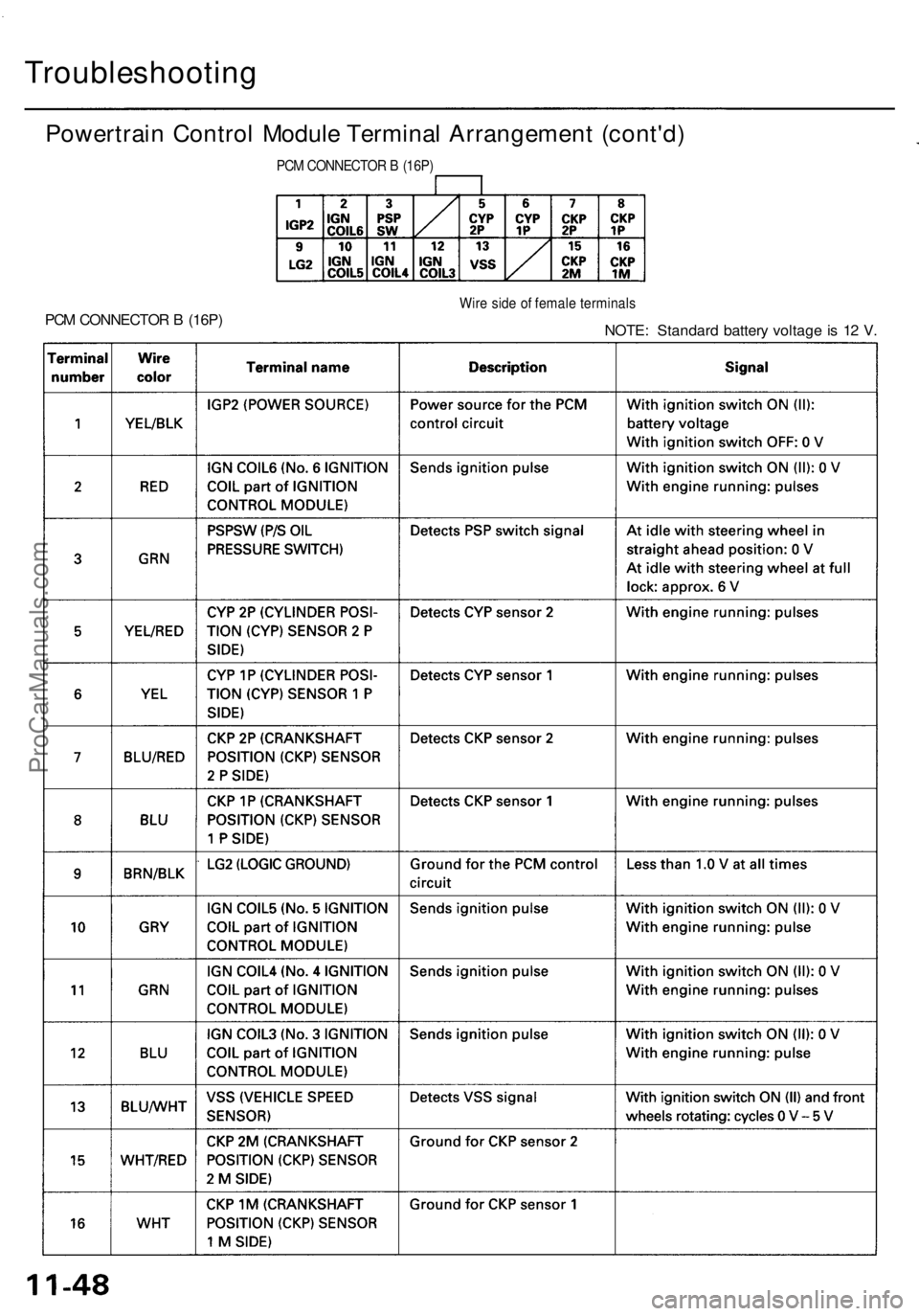
Troubleshooting
Powertrain Control Module Terminal Arrangement (cont'd)
PCM CONNECTOR B (16P)
Wire side of female terminals
NOTE: Standard battery voltage is 12 V.
PCM CONNECTOR B (16P)ProCarManuals.com
Page 548 of 1954
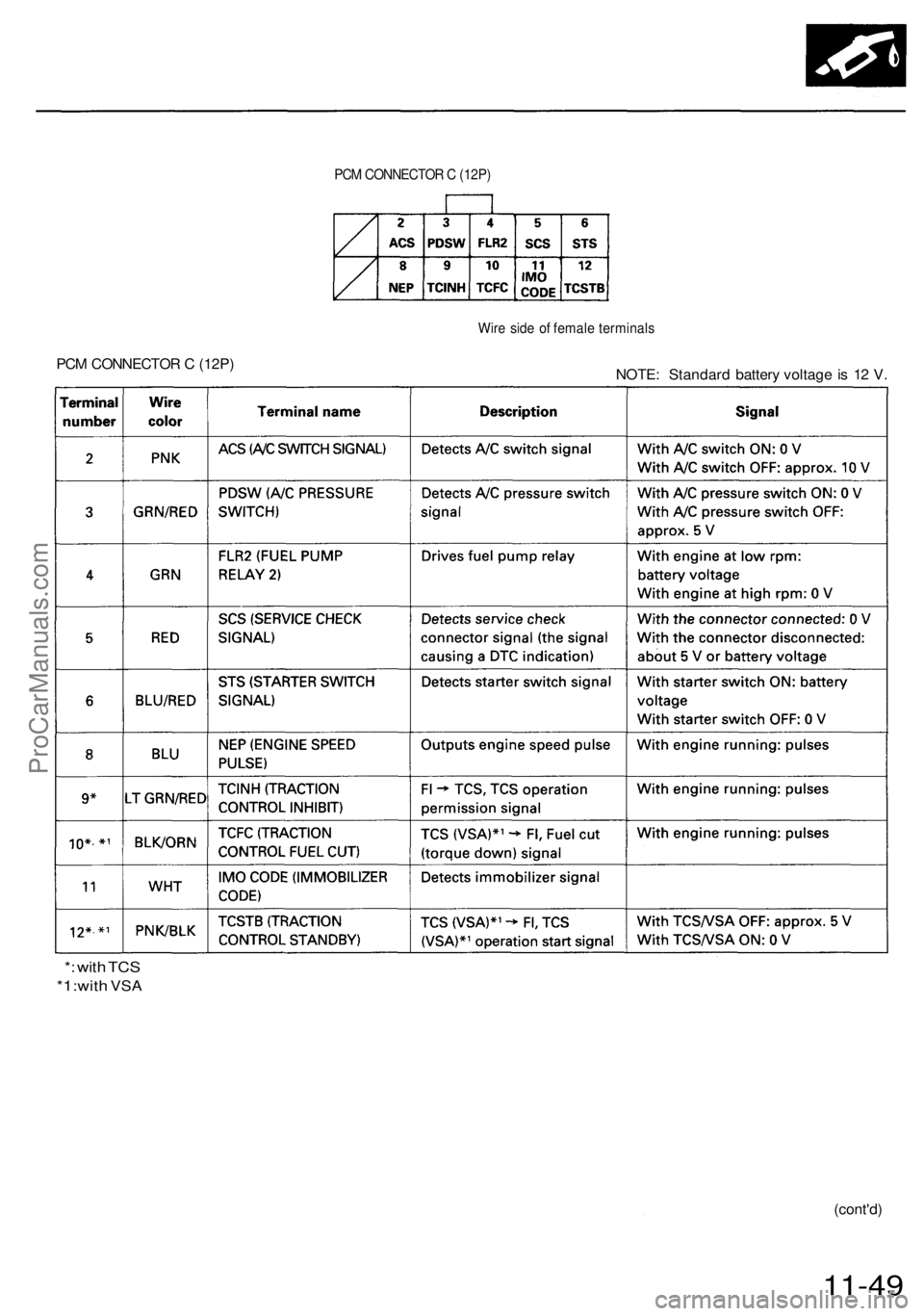
PCM CONNECTOR C (12P)
Wire side of female terminals
PCM CONNECTOR C (12P)
NOTE: Standard battery voltage is 12 V.
*: with TCS
*1:with
VSA
(cont'd)
11-49ProCarManuals.com
Page 549 of 1954
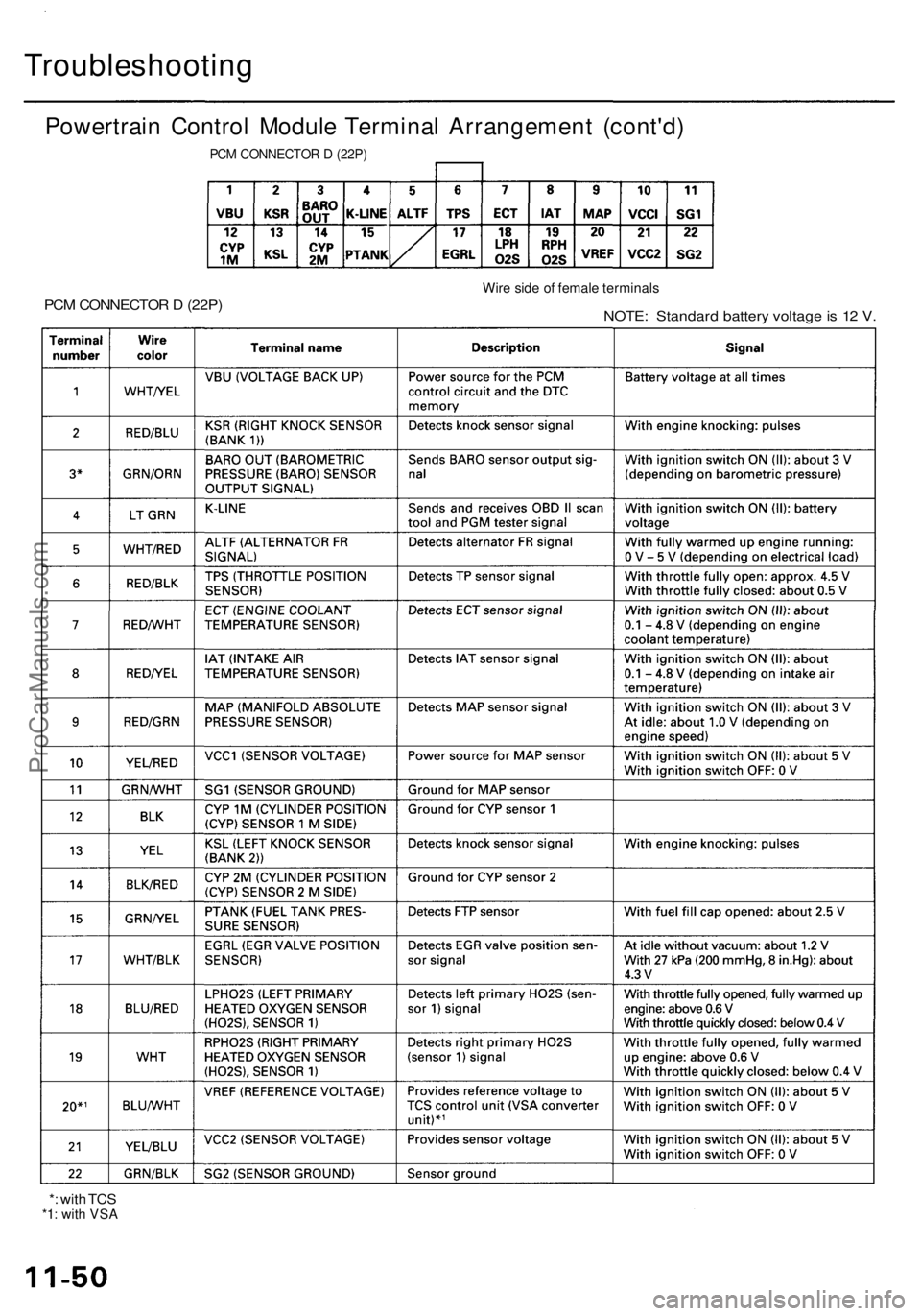
Troubleshooting
Powertrain Control Module Terminal Arrangement (cont'd)
PCM CONNECTOR D (22P)
Wire side of female terminals
*: with TCS
*1: with VSA
NOTE: Standard battery voltage is 12 V.
PCM CONNECTOR D (22P)ProCarManuals.com
Page 550 of 1954
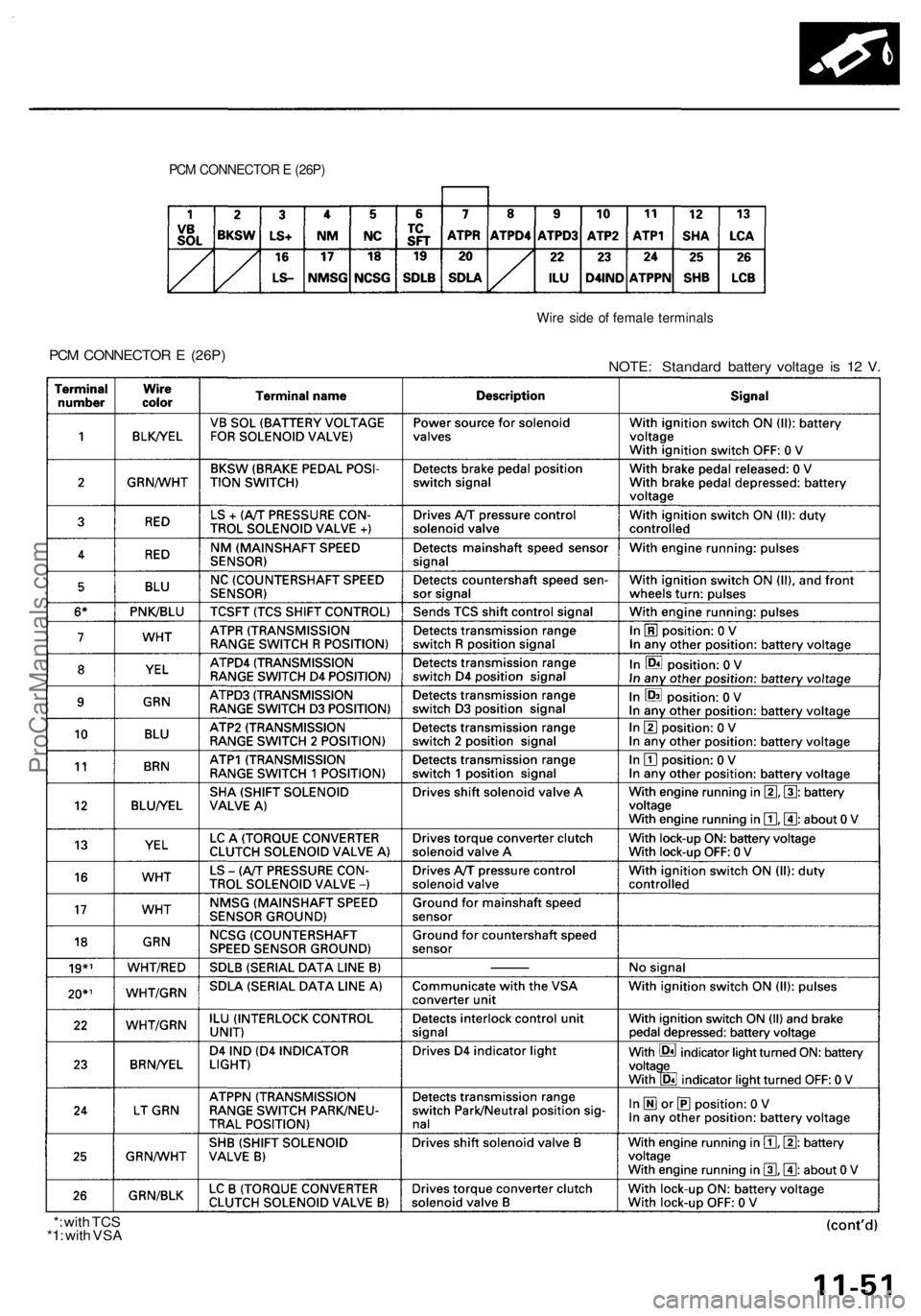
PCM CONNECTOR E (26P)
PCM CONNECTOR E (26P)
Wire side of female terminals
NOTE: Standard battery voltage is 12 V.
*: with TCS
*1: with VSAProCarManuals.com